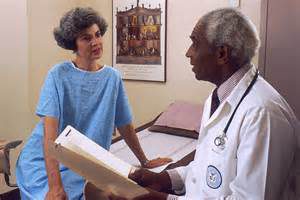The Doctor-Patient Relationship is Alive and Well
 by Danielle Ofri
by Danielle Ofri
New York Times
It’s 2:20 p.m. and Ms. M. is precisely on time for her appointment. She’s brought her hand-printed list of questions, her sack of medications that need renewal, her mordant observations about her newest home attendant, and a box of chocolates that she will press upon me no matter how hard I protest. At 89, her medical conditions don’t have easy cures and the setbacks from aging are often implacable. Yet we always manage to find something optimistic to work on, even if modest in scope.
Ms. M. requires the assistance of her daughter to make the hour-plus trip by public transportation. Over the 10 years we’ve worked together, I’ve periodically suggested she might consider a clinic closer to home to avoid the arduous travel. She sniffs sharply at the affront and then barrels into the meat of our visit.
It’s been a rocky decade for medicine — the Affordable Care Act, the migration to electronic medical records, record-breaking medication prices, and the shift from traditional doctor-run practices to mammoth corporate-run organizations have left us all reeling. Physician anger at overwhelming administrative demands and patient frustration at the impossibility of navigating the system have frayed the fortitude of everyone.
Medicine is unquestionably harder than it was 10 years ago. Many more doctors I know talk about quitting (an option that is not equally available to patients). However, there’s been no mass exodus of doctors. We doctors grumble loudly — often with good cause — but we aren’t quitting in droves, mainly because of patients like Ms. M.
A new study by the Physicians Foundation of more than 1,500 patients found that more than 90 percent of patients were satisfied with their relationship with their primary care doctor. They felt that their doctors were respectful of them, listened well, explained well, and had a good understanding of their medical history.
On the surface, this seems to contradict the dyspeptic view of medicine we hear about in the media. But it actually reflects the larger truth that most patient rancor is directed not toward the doctor but to the bureaucratic aspects of medicine — the cost, the hassle, the opaqueness. On the whole, patients are happy with the medical care they receive from their primary care doctors — once they’ve slogged through the seven circles of pre-authorization purgatory to get there.
The same is true for doctors. What doctors hate most is everything that surrounds medicine, but not medicine itself. Peel away the administrative migraines and most doctors relish the practice of medicine.
It’s heartening to see that the doctor-patient relationship is surviving this latest round of upheaval. For primary care doctors in particular, whose daily work life has been pummeled with exceptional relentlessness, this latest survey is immensely validating.
So maybe it’s not surprising that it can feel as if morale is both exceptionally high and exceptionally low at the same time. Just this month, a new set of requirements was piled on to our clinic’s electronic medical record system, and a dreary sigh of resignation echoed from one doctor to the next. With all the computerized busywork that a medical visit requires these days, there’s hardly time to call in our patients from the waiting room.
On the other hand, when we welcome our new students and interns — July is the starting month of the medical calendar — the enthusiasm for primary care is fervent. We all have patients, like Ms. M., who bring joy and fulfillment no matter how much inanity we have to lumber though in the electronic medical records system.
Nothing comes close to the experience of making another human being feel better, even a tiny bit. After months of trial and error, Ms. M. and I finally worked out a schedule of her diuretic pill such that she could go for a midday stroll without having to scramble for a nonexistent public bathroom. This isn’t the sort of high-tech medical wizardry that grabs headlines or stock prices, but it allows a formerly housebound patient to now keep tabs on her Brooklyn neighborhood.
The awe of discovering the human body, the honor of being trusted to give advice, the gratification of helping someone through a difficult illness, the intellectual stimulation of continually learning — these things never grow old.
And word seems to be getting out — applications to medical school are at an all-time high, and new medical schools are opening to meet the demand. (By comparison, law school applicationscontinue to decline and business school applications remain flat.)
When I close the door to the exam room and it’s just the patient and me, with all the bureaucracy safely barricaded outside, the power of human connection becomes palpable. I can’t always solve my patients’ issues, but the opportunity to try cannot be underestimated.
We doctors shouldn’t be afraid to speak up about what’s wrong with medicine — and there is plenty that is wrong. But we also shouldn’t be afraid to speak up about what’s right. While the logistics of practicing medicine may feel like an ever-tightening thumbscrew, the doctor-patient relationship is alive and well, and the prognosis is excellent. (from the New York Times)
